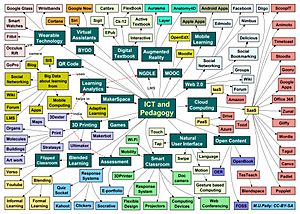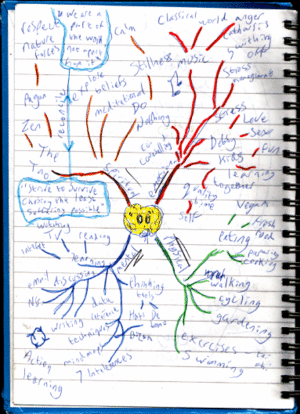Mind map facts for kids
A mind map is a special kind of drawing that helps you organize your thoughts. Imagine a central idea or topic in the middle of a page. Then, you draw lines connecting other related words, ideas, or tasks to that main topic. It's like a visual web of information!
Mind maps are super helpful for many things. They can help you remember information for school, plan projects, solve problems, or even make important decisions. They help you see how different ideas connect.
How to Create a Mind Map
Tony Buzan, who helped popularize mind maps, shared some helpful tips for making them. These guidelines can make your mind maps even better:
- Start in the middle of your page with a picture of your main topic. Use at least three different colors for this.
- Use lots of pictures, symbols, and even secret codes throughout your mind map.
- Pick only the most important words. Write them clearly using either capital or small letters.
- It's best to put each word or picture on its own line.
- Make sure all your lines are connected, starting from your central picture. The lines should get thinner as they move away from the center.
- Try to make the lines the same length as the word or picture they support.
- Use many different colors in your mind map. This makes it more fun to look at and helps you group ideas.
- Don't be afraid to create your own unique style of mind mapping.
- Use bold lines or bigger pictures to show what's most important. Also, show how different ideas are linked.
- Keep your mind map neat and easy to understand. You can use a "tree" structure to organize your branches.
Why Use Mind Maps?
Mind maps are powerful tools, much like other diagrams. They can help you come up with new ideas, see them clearly, and organize them. They are also great for studying and organizing information. You can use them to solve problems, make decisions, and even help with writing.
Mind maps are useful in many parts of your life. You can use them for school, family plans, or even business ideas. Here are some common ways people use them:
- Taking Notes: Instead of writing long sentences, you can quickly jot down key ideas and connect them.
- Brainstorming: When you need lots of ideas, you can put them all around a central topic without worrying about order. You can organize them later.
- Summarizing: Mind maps help you quickly get the main points of a book or lesson.
- Memory Aid: They can act like a memory trick to help you remember complicated information.
- Sorting Ideas: If you have a really big or confusing idea, a mind map can help you break it down and understand it better.
Mind maps are also a fun way to work with others. You can use colorful pens and create ideas together!
Images for kids
-
A mind map about the cubital fossa or elbow pit, including an illustration of the central concept
See also
 In Spanish: Mapa mental para niños
In Spanish: Mapa mental para niños




